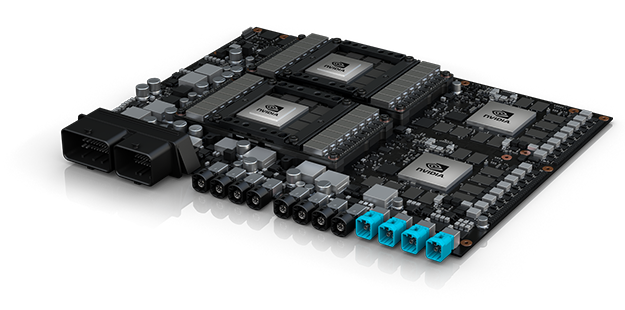
NVIDIA today unveiled the world's first artificial intelligence computer designed to drive fully autonomous robotaxis.
The new system, codenamed Pegasus, extends the NVIDIA® DRIVE™ PX AI computing platform to handle Level 5 driverless vehicles. NVIDIA DRIVE PX Pegasus delivers over 320 trillion operations per second -- more than 10x the performance of its predecessor, NVIDIA DRIVE PX 2.
NVIDIA DRIVE PX Pegasus will help make possible a new class of vehicles that can operate without a driver -- fully autonomous vehicles without steering wheels, pedals or mirrors, and interiors that feel like a living room or office. They will arrive on demand to safely whisk passengers to their destinations, bringing mobility to everyone, including the elderly and disabled.
Millions of hours of lost time will be recaptured by drivers as they work, play, eat or sleep on their daily commutes. And countless lives will be saved by vehicles that are never fatigued, impaired or distracted -- increasing road safety, reducing congestion and freeing up valuable land currently used for parking lots.
Of the 225 partners developing on the NVIDIA DRIVE PX platform, more than 25 are developing fully autonomous robotaxis using NVIDIA CUDA GPUs. Today, their trunks resemble small data centers, loaded with racks of computers with server-class NVIDIA GPUs running deep learning, computer vision and parallel computing algorithms. Their size, power demands and cost make them impractical for production vehicles.
The computational requirements of robotaxis are enormous -- perceiving the world through high-resolution, 360-degree surround cameras and lidars, localizing the vehicle within centimeter accuracy, tracking vehicles and people around the car, and planning a safe and comfortable path to the destination. All this processing must be done with multiple levels of redundancy to ensure the highest level of safety. The computing demands of driverless vehicles are easily 50 to 100 times more intensive than the most advanced cars today.
"Creating a fully self-driving car is one of society's most important endeavors -- and one of the most challenging to deliver," said Jensen Huang, NVIDIA founder and CEO. "The breakthrough AI computing performance and efficiency of Pegasus is crucial for the industry to realize this vision.
"Driverless cars will enable new ride- and car-sharing services. New types of cars will be invented, resembling offices, living rooms or hotel rooms on wheels. Travelers will simply order up the type of vehicle they want based on their destination and activities planned along the way. The future of society will be reshaped," he said.
Broad Industry Support Virtually all carmakers, transportation as a service companies, as well as startups are using NVIDIA AI in the development of Level 5 vehicles.
"NVIDIA gets it. And their DRIVE PX Pegasus will get us to Level 5." -- Tim Kentley-Klay, CEO and co-founder, Zoox
"We plan to put NVIDIA DRIVE PX Pegasus into production in our autonomous vehicles." -- Sertac Karaman, president and co-founder, Optimus Ride
"The breakthrough AI performance and capabilities of the NVIDIA DRIVE PX Pegasus platform will ensure the reliability and safety of our autonomous trucking fleet." -- Xiaodi Hou, CTO, TuSimple
"NVIDIA DRIVE PX 2 is the brain of our self-driving prototypes, and we can't wait to get our hands on NVIDIA DRIVE PX Pegasus." -- Dmitry Polischuk, head of self-driving, Yandex.Taxi
"NuTonomy is building for Level 5 and Pegasus is the kind of platform that will be required to support these types of systems." -- Karl Iagnemma, CEO and co-founder, NuTonomy
"Today dozens of companies are racing to develop robotaxis, but they are still gated by the massive computation needs of a truly driverless car," said Luca De Ambroggi, senior principal automotive analyst at IHS Markit. "The new NVIDIA DRIVE PX Pegasus shows the path to production for the automakers, startups and automotive ecosystem working to deliver this amazing vision."
Product Specifications NVIDIA DRIVE PX Pegasus is powered by four high-performance AI processors. It couples two of NVIDIA's newest Xavier system-on-a-chip processors -- featuring an embedded GPU based on the NVIDIA Volta architecture -- with two next-generation discrete GPUs with hardware created for accelerating deep learning and computer vision algorithms. The system will provide the enormous computational capability for fully autonomous vehicles in a computer the size of a license plate, drastically reducing energy consumption and cost.
Pegasus is designed for ASIL D certification -- the industry's highest safety level -- with automotive inputs/outputs, including CAN (controller area network), Flexray, 16 dedicated high-speed sensor inputs for camera, radar, lidar and ultrasonics, plus multiple 10Gbit Ethernet connectors. Its combined memory bandwidth exceeds 1 terabyte per second.
NVIDIA DRIVE PX Platform The NVIDIA DRIVE PX platform scales from a single mobile processor configuration delivering Level 2+/Level 3 capabilities to a combination of multiple mobile processors and discrete GPUs for full Level 5. These configurations run on a single, open software architecture. This enables automakers and tier 1 suppliers to move from development into production for a wide range of self-driving solutions -- from AutoCruise on the highway, to AutoChauffeur for point-to-point travel, to Pegasus for a fully autonomous vehicle.
NVIDIA DRIVE PX is part of a broad family of NVIDIA AI computing solutions. Data scientists who train their deep neural networks in the data center on the NVIDIA DGX-1™ AI supercomputer can seamlessly run on NVIDIA DRIVE PX inside the vehicle. The unified architecture enables the same NVIDIA DRIVE software algorithms, libraries and tools that run in the data center also perform inferencing in the car.
This cloud-to-car approach enables cars to receive over-the-air updates to add new features and capabilities throughout the life of a vehicle.
Availability Pegasus will be available to NVIDIA automotive partners in the second half of 2018. NVIDIA DriveWorks software and NVIDIA DRIVE PX 2 configurations are available today for developers working on autonomous vehicles and algorithms. More information is available at www.nvidia.com/drive.

 O-Sense
O-Sense







.png)

